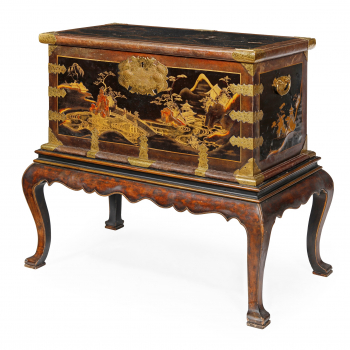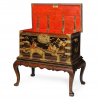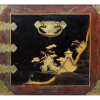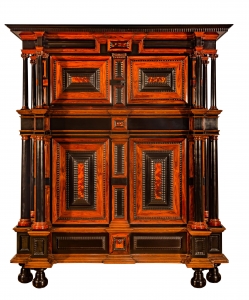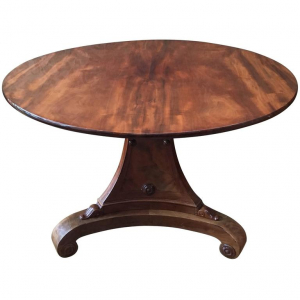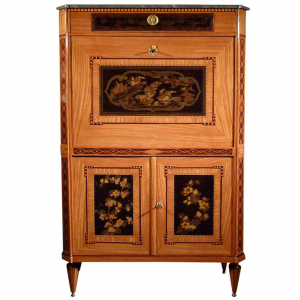Japanese lacquer chest on stand
Rectangular lacquer chest with flat hinged lid, executed in black and gold reliëf lacquer, decorated with mountainous landscapes, with gilt-copper mounts, the lid with restorations, on later stand.
n the seventeenth century in The Netherlands and elsewhere in Europe, there was a growing interest in exotica. Because of voyages and trade, for example, the Dutch East India Company with overseas territories, the Dutch came in contact with exotic objects. Because they came from far away they were exclusive. For wealthy citizens they formed an attractive way to diffirentiate. In China and Japan they made beautiful lacquerware and porcelain which was very popular in the seventeenth century in Dutch and other Western interiors. Wealthy citizens and noble people decorated their houses with rare Oriental objects. European Royal houses eagerly bought at auctions of the Dutch East India Company.
Japanese export lacquerware was one of the many goods that the VOC shipped from Asia to Europe. The lacquerwork was made in Japan for export and delivered in all forms, such as suitcases, trunks, boxes and cabinets. Making Japanese lacquerware was fiddly, took a lot of time and was very expensive. Eventhough the lacquerwork was popular, it did not bring the VOC much profit because of the size of the objects, they took up to much space in the hold of the ship. The trade in Japanese lacquerware was therefore only a small part of the VOC trade with Japan. It was purchased on a limited scale, initially in Hirado and after 1641 in Nagasaki. Since then the trade went through Deshima, a small artificial island in the Bay of Nagasaki. Especially in the seventeenth century lacquerware came to Europe. The highlight of the trade in Japanese lacquerware was between 1635 and 1670.
- Price
- € 15000
- Origin
- Private Collection, England.
- Period
- late 17th century
- Material
- Japan Lacquer
- Dimensions
- 45 x 90.5 x 46 cm
- Reference
- 0017

